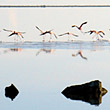| Published: Date: Updated: Author: |
The Bahamas Investor Magazine January 4, 2007 January 4, 2007 Jessica Robertson |
Throughout its long history, The Bahamas has relied heavily on mass tourism to fuel its economy. Statistics show, however, that much like the country’s population, the vast majority of tourism-related revenue—more than 70 per cent—is based in New Providence and Grand Bahama.
But with more than 700 islands and cays boasting a unique variety of flora, fauna and culture, the country has a singular opportunity to diversify its tourism offerings to appeal to a wide variety of niche markets.
One such niche market is ecotourism, an increasingly popular offshoot of the tourism market. “Ecotourism is a relatively new concept that is often misunderstood,” says Ministry of Tourism general manager of ecotourism, Sheila Cox. “We define it as travel to fragile, pristine and protected areas, usually on a small scale. It helps educate travellers. Travellers today want to know more. It’s about more than just sand, sea and sun,” she explains.
In order to preserve the untouched areas found throughout the Family Islands while capitalizing on the growing interest in a different kind of travel experience, tourism officials have been working alongside the Inter-American Development Bank (IDB) to formulate the Regional Plan for the Sustainable Development of Inagua.
Keeping the balance
The Bahamian tourism industry developed organically. It flourished and, to a large degree, supported an entire nation with very little forethought or planning. The IDB project, however, represents a change in approach to that development. Tourism growth on undeveloped and pristine Out Islands will be planned and carefully managed.
The Inagua project is designed to ensure that the island’s future development is carried out in an environmentally, economically and socially sustainable manner.
The southernmost island of the Bahama island chain, Inagua was selected for the pilot programme for a number of reasons. First, and most critically, the island’s economy needs it. For years, Inagua’s population of less than 1,000 residents has relied almost exclusively on the Morton Salt Company for its economic stability. If the economy is to grow and stabilize going forward, diversification is crucial. Second, the island possesses all of the elements necessary to evolve into a thriving ecotourism destination.
“Ecotourism is the way to go. This is the niche market that the Family Islands, and Inagua in particular, lend themselves to perfectly,” says Cox. “We don’t have to go creating anything. It’s already there.”
Coexistence in an ideal setting
Inagua is perhaps best known for being home to the world’s largest population of West Indian flamingos. The 80,000 birds and the Morton Salt Company have long shared a symbiotic relationship—the flamingos feed primarily on the brine shrimp that live in the salt lagoons, helping the company keep the lagoons virtually algae-free.
In addition to the flamingos, hundreds of other bird species call Inagua home. Goats, donkeys and turtles also roam freely. There are tremendous deep sea fishing resources and coral reefs for snorkelling. Inagua also boasts a rich history, something Cox says can, with some funding and vision, provide the basis for a fascinating cultural and historical tour.
Already, representatives working on the plan have met with locals to ensure that they are on board with the intended vision for their island and have begun working alongside interested entrepreneurs to ensure that their ideas are in line with the master plan. IDB officials have also been working to gain the necessary funding to make the collective vision a reality.
If all goes according to plan, Inagua will no longer be “the best kept secret in The Bahamas” as the words to a local Geno D song suggest. Rather, it will be the island about which everyone is talking.









